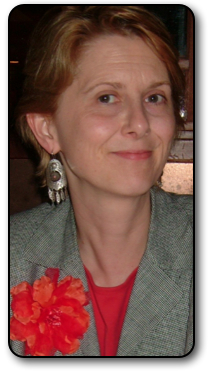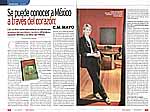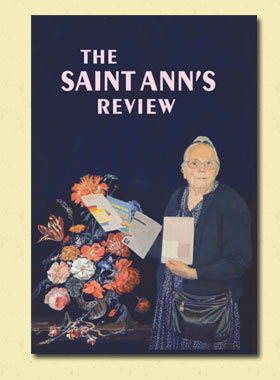|
 
Q &
A with the Editor of
Mexico: A Traveler's Literary Companion,
C.M. Mayo (2006)
Mexico is such a
wonderful collection of Mexican literary writing. How exactly
is it "a traveler's companion"?
C.M. Mayo:
For
Mexico City, you might read Juan Villoro's short story "One-Way
Street" about punk rockers set the exclusive Pedregal neighborhood;
for the U.S.-Mexico border, you might read Carlos Fuentes' novel
excerpt, "Malintzin of the Maquilas" about factory
workers in Ciudad Juárez.
There's an enormous variety. You can travel in your armchair,
too, from Tecate to Oaxaca to Chiapas to Yucatán. Good stories are a
different kind of map—
one that can be much more profound.
So
it's a way of deepening one's travels, of getting below the surface
of things.
Exactly. Just as the U.S. is more than Disneyland and shopping
malls, Mexico is infinitely more than Cancun, Los Cabos, and
border towns. I love the quote at the beginning of each of the
Traveler's Literary Companion books, the one by Alistair Reed:
"Coming newly into Spanish, I lacked two essentials—a childhood in the language,
which I could never acquire, and a sense of its literature, which
I could."
Did
you have a childhood in the language?
I learned Spanish when I got married and moved to Mexico City
in 1986. My husband, Agustín Carstens, is Mexican. I am fluent,
but he catches things for me that only a native speaker could.
I like to say he's my "secret weapon."
For
example?
In the Mónica
Lavín
story, "Day and Night", which is set in a vacation
house near Cuernavaca, the children have a supper of "platillos
voladores." The literal translation would be "flying
saucers" but that didn't make sense. Thanks to my husband
(who had, as a child, eaten many a "platillo volador"),
that got translated as "the grilled sandwiches they called
'flying saucers.'"
When
did you begin translating?
About twelve years ago, when I started reading the Mexico City
magazine, Vuelta. I could see that there was an enormous
amount of superb writing and poetry in Mexico, and that very
little of it was being translated into English. In 1994, the
poet Naomi Shihab Nye invited me to send some translations of
Mexican poetry for her anthology, The
Tree Is Older Than You Are. Soon afterward I founded Tameme, the bilingual (English/Spanish)
literary journal.
How
did you get the idea to do this book?
Strangely,
the idea to do an anthology of Mexican literary writing popped
into my mind while I was walking. I say "strangely"
not because it's unusual to get ideas while walking, but because
shortly thereafter, I got a phone call from David Peattie of
Whereabouts
Press,
inviting me to do the Mexico book for his "Traveler's Literary
Companion" series. I had thought of doing a straightforward
anthology, not of this kind, I mean, one that provides not only
an introduction to the literary voices of the country, but also
a portrait of the country itself. I thought it was a brilliant
concept.
How
did you go about finding the pieces for Mexico?
There
were a few pieces I knew I had to include— Juan Villoro's "One-Way Street"
(Mexico City) and Agustin
Cadena's "Lady of the Seas" (Baja California), for example. I couldn't
imagine a Mexico anthology without something by Carlos
Fuentes, and for Chiapas, there had to be a piece by Rosario
Castellanos. Some of the pieces I can't say I found— they just fell into
my lap. Right about the time I began reading for this, I received
the manuscript of Daniel Reveles' collection of short stories
set in the U.S.-Mexico border town of Tecate. His publisher sent
it to me, looking for a blurb. I was happy to give him one because
it's a fantastic collection, vivid and full of heart. In there
was the hilarious short story, "Big Caca's Revenge."
It
sounds fairly straightforward.
Not at all! I delved into several months of reading. I read as
widely as I could, both in Spanish, for pieces to translate,
and in English translation, for work to reprint. I asked all
my Mexican friends for advice. And I did something quite different,
I think, from what most anthologists of translation usually do.
From editing Tameme, and from friends in
the American
Literary Translators Association, I knew that there are many outstanding
translations that have not yet been published, and many that
end up in literary magazines, somewhat obscurely published. So
I made up a "call for submissions" and sent it out
over the Internet to hundreds of translators and writers. I also
took out classified ads in Poets & Writers and AWP
Chronicle, and in addition, I snail-mailed a flyer to 650
Spanish and translation Departments in universities throughout
the U.S., Canada, the U.K.— even Australia. I knew it would be important
to cast the net wide—
as wide as possible.
Why
was "casting the net wide" so important?
Because the literary scene in Mexico is concentrated in the capital— it flat-out dominates
the cultural life of the nation. Mexico City does not have a
counterpart in the U.S. You might think of it as New York, Boston,
San Francisco, Los Angeles, Miami and Washington D.C. all rolled
into one. Now, I wanted to have an anthology of the best Mexican
literary writing I could find, but at the same time, provide
a portrait of Mexico as a whole. So I needed something set in
Sinaloa, set in Oaxaca, set in Puebla, and so on. And I also
wanted to include first-rate writers from or currently living
in places outside the capital. It couldn't be all famous Mexico
City writers— and
it certainly wouldn't make sense to include writing that doesn't
have a sense of place or is set in, say, Paris.
So
the Internet was a help.
Enormous! Back in the late 90s when I started Tameme, few Mexican writers
had e-mail. It was very hard to track people down; letters and
manuscripts got lost in the mail. Nowadays many Mexican writers
have their own webpages. Just for instance, Mónica
Lavín and Alberto Ruy Sánchez. (See the contributors
page
for more links.)
Who
are some of the writers that your "net" drew in? Were
there any writers whom you didn't know about or whose work in
some way surprised you?
The biggest
surprise was "Tarantula," the story by Raymundo Hernández-Gil. Daryl Hague,
a professor of Spanish at Brigham Young University, in Provo,
Utah, had translated his story and when he saw my "call
for submissions" he mailed it in. Hernández-Gil was born in
the state of Veracruz, where the story is set, and had only published
his work in Spanish in a
Brigham Young University student journal. I could have asked
everyone in Mexico City and not a one would have known about
this story.
How
is Mexican writing different from U.S. writing?
Individual writers are so different from one another that I find
it difficult to make generalizations. But I do have one: in my
experience, Mexican writing, more often than American writing,
tends toward macabre subjects. I had always shied away from cliches—
you know, "Mexicans
are obsessed with death" etc. But when I looked at the stories
and novel excerpts and essays I'd found, well, for the most part,
I had to admit, the subject matter was death-obsessed. There's
often a very dark sense of humor, similar to Flannery O'Connor's.
Are
there stories set in Texas— any "Tejano"
stories?
No, though there are two border stories— the one by Carlos Fuentes is set in
Ciudad Juárez,
and the one I mentioned set in Tecate, just south of the California
border, by Daniel Reveles. Everything in this book is set in
Mexico. But certainly, another anthologist might have defined
"Mexican" differently than I did. The border gets very
blurry. I should add that it's not that definitions are so important
to me; rather, the publisher gave me a strict limit the number
of pages I could include. Such are the economics of publishing...
That said, it's a good sized book at 256 pages.
Did
many translators respond to your "call for submissions"?
Oh yes, Geoff Hargreaves sent me his translation of Ricardo Elizondo
Elizondo's "The Green Bottle" (set in the Northern
Desert); Eduardo Jiménez
sent me Bruno Estañol's
"Fata Morgana" (set in the state of Tabasco); Amy Schildhouse
Greenberg sent Ángeles
Mastretta's "Aunt Elena" (state of Puebla); and Philip
Garrison sent Raúl
Mejía's
"Banquets" (set in Morelia, Michoacán)— just to give a few examples.
I translated six pieces myself, and a few more were commissioned.
But I think the number of fantastic pieces sent by translators
shows how, in shaping how we view another culture, translators
really are leaders.
Leaders?
What do you mean?
Imagine you are a Mexican, and imagine that you have never seen
a book by Joyce Carol Oates. You have no clue that such writers
as Ann Patchett, Amy Tan, Ted Conover, Dave Eggers or Edwidge
Danticat exist. Imagine that all you knew about U.S. culture
came from watching TV, the movies, and taking a trip or two to
Houston to go shopping in an outlet mall by a freeway. We have
a thriving literary culture in the United States, and it's not
concentrated in one place, but widely dispersed. There are major
writers working in New York and Boston, but also in Washington
D.C., Iowa, Seattle, Alaska, Houston— you name it. If you knew nothing about
our literary culture, it would be easy to come to some unfairly
disparaging conclusions about us as a people. You might say,
as many Mexicans do, "Americans have no culture." With
literary work, not always, but many times, it is the translator
who takes the initiative to do the translation, rather than being
hired by someone else, a publisher or an editor.
So
translation lays a bridge across a gulf of ignorance.
(Laughs). Yes.
Why
isn't more Mexican writing being translated?
For the
same two reasons that very little literarature in any language
is being translated. First, readers have a natural bias toward
their own culture; second, cost. Translation can be expensive!
What
about grants?
The sources are few. The National Endowment for Arts, for example, offers
a modest program of grants for literary translators, a does PEN. The Mexican government
also has a fellowship program for translators. But in all, I
think it fair to say that grants are scarce and to get one requires
substantial time, effort, and luck.
What
do you think should be done about this?
All sorts of things! One model is that of Whereabouts Press, which publishes this
Traveler's Literary Companion Series. It's a way of packaging
translations, making them more appealing and accessible to readers.
Many people who have bought one title in the Traveler's Literary
Companion Series go on to buy another. I've got the Chile,
Cuba, Costa Rica, Spain, Vietnam, Greece, and Italy— and when Morocco
comes out, I'll also get that one, since I plan to travel there.
If I do say so myself, all the Traveler's Literary Companions
are quite good reading!
Do
you think translation should be subsidized?
I can
tell you that I myself subsidize it. I'm the founding editor
of Tameme, a bilingual literary
journal. No literary journal I know of makes a profit. Now Tameme
publishes chapbooks— short
stories, poetry, and so on, beautiful work, I think, but I don't
measure the value of it purely by the numbers of copies I can
sell. It's a labor of love, really.
Do
you think Mexico will encourage more translation of Mexican
writing?
I sincerely hope so. May more readers develop a taste for Mexican
writing, and go out and look for the Mexican work that is already
out there in translation—
and look for the books that will be out there.
Who
are some of the Mexican writers you think should be translated?
All of
the writers in the anthology have untranslated work—
translators, go
to it! In addition to the writers in my anthology, I suggest
Juvenal Acosta; José Agustín; Homero Aridjis; Juan
José Arreola; Rosa Beltrán; Sabina Berman; Alberto
Blanco; Carmen Boullosa; Fabienne Bradu; Federico Campbell; Carlos
Chimal; Luis Humberto Crothswaite; Elena Garro; Ana Garcia Bergua;
Adolfo Bioy Casares; Guillermo Fadanelli; Sergio Galindo; Margo
Glantz; Cristina Gutiérrez Richaud; David Huerta; Francisco
Hinojosa; Barbara Jacobs; Jorge Ibargüengoitia; Esther Krauze;
Hernán Lara Zavala; Fabio Morábito; Silvia Molina; Carlos Montemayor;
Salvador Novo; Jose Emilio Pacheco; Aline Pattersen; Octavio
Paz; Ignacio Padilla; Elena Poniatwoska; Sergio Pitol; María
Luisa Puga; Luis Arturo Ramos; José Revueltas; Juan Rulfo;
Daniel Sada; Guillermo Samperio; Enrique Serna; Ignacio Solares,
Paco Ignacio Taibo II; Jorge Volpe; Agustín Yañez;
Luis Zapata. And of course, new writers are always cropping up.
That's
a very long list.
I am sure it should be longer! There are so many wonderful Mexican
writers, readers in English have no idea. And I didn't even get
to the Mexican poets!
Do
you have any advice for anyone who wants to try doing literary
translation?
It's
a labor of love—
I think one has to approach it in this spirit. If you want to
make a living at it, you'll probably find it very frustrating.
Now, if you're doing it as a labor of love, you might as choose
what you like, what you think deserves to be translated.
So stay away from the obvious, the best-sellers, the works that
have already been translated. Look for the unusual, the quirky,
what speaks to you. Don't feel you have to be perfectly
bilingual before you start. What you really need is to take painstaking
care and have an ability to write at the same level as the author
in your own language. (Many of the best literary translators
are poets.) Finally, if you want to publish it, get permission.
There are some excellent websites with information for literary
translators. One of the best is the website of the American
Literary Translators Association. Be sure to also visit PEN.
What
is your favorite place in Mexico?
Right now it's a toss-up between the garden of Las Mañanitas in Cuernavaca and
Isla Espíritu
Santo, an island off La Paz in the Sea of Cortez. If you'd asked
me last week, I might have told you the garden of the Dolores
Olmedo museum in Mexico City.
 More interviews
with C.M. Mayo More interviews
with C.M. Mayo
Featured on National Public Radio, click to listen in now!

 More
translations by C.M. Mayo More
translations by C.M. Mayo |
 John Ydstie interviews
C.M. Mayo about literary translation and Mexico: A Traveler's
Literary Companion. April 1st 2006. National Public Radio "All
Things Considered." John Ydstie interviews
C.M. Mayo about literary translation and Mexico: A Traveler's
Literary Companion. April 1st 2006. National Public Radio "All
Things Considered."
 An interview (in Spanish)
by Dolia Estevez about Mexico: A Traveler's Literary Companion,
Miraculous Air, and Tameme. October 2007. An interview (in Spanish)
by Dolia Estevez about Mexico: A Traveler's Literary Companion,
Miraculous Air, and Tameme. October 2007.
Poder
y Negocios.
Mexican
writer Luis Felipe Lomelí asks questions in English; C.M. Mayo contesta
en español (with English transcript)
December 2018
 John Bennett interviews
C.M. Mayo about The Last Prince of the Mexican Empire—
and some of the stories (by Araceli Ardón, Fernando del Paso,
Mónica Lavín) in Mexico: A Traveler's
Literary Companion. Whereabouts Press Blog. John Bennett interviews
C.M. Mayo about The Last Prince of the Mexican Empire—
and some of the stories (by Araceli Ardón, Fernando del Paso,
Mónica Lavín) in Mexico: A Traveler's
Literary Companion. Whereabouts Press Blog.
 Editor Margot Shetterley interviews C.M.
Mayo on writing about and translating in Mexico. June 2007. Inside Mexico. Editor Margot Shetterley interviews C.M.
Mayo on writing about and translating in Mexico. June 2007. Inside Mexico.

Editor Beth Bosworth
interviews C.M. Mayo. Summer / Fall 2008.
Saint
Ann's Review.
 Tonya and Ian Fitzpatrick
interview C.M. Mayo about Mexico: A Traveler's Literary Companion, Miraculous Air and Mexico's Baja California
peninsula, Mexico City,the forthcoming novel, The
Last Prince of the Mexican Empire, and more. January 6, 2009. Tonya and Ian Fitzpatrick
interview C.M. Mayo about Mexico: A Traveler's Literary Companion, Miraculous Air and Mexico's Baja California
peninsula, Mexico City,the forthcoming novel, The
Last Prince of the Mexican Empire, and more. January 6, 2009.
Travel'n
On Radio.

Elizabeth Wadell
interviews C.M. Mayo on the Wide World of Mexican Fiction. Summer
2007.
The
Quarterly Conversation
Eight
Diagrams
Wayne E. Yang, photographer, writer, and litblogger extraordinaire,
interviews C.M. Mayo about literary translation and Mexico:
A Traveler's Literary Companion. June 30, 2006. Eight Diagrams
 More interviews. More interviews.
Many of the more recent interviews about later books also discuss
Mexico: A Traveler's Literary Companion, Mexico, and translation.

|



